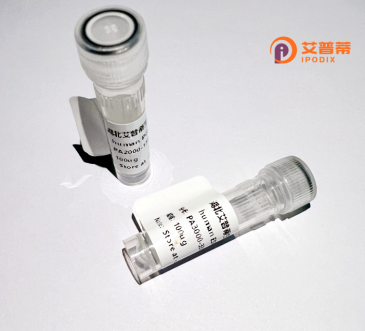
| 纯度 | >90%SDS-PAGE. |
| 种属 | Human |
| 靶点 | CDCA7L |
| Uniprot No | Q96GN5 |
| 内毒素 | < 0.01EU/μg |
| 表达宿主 | E.coli |
| 表达区间 | 1-454aa |
| 氨基酸序列 | MELATRYQIPKEVADIFNAPSDDEEFVGFRDDVPMETLSSEESCDSFDSLESGKQQDVRFHSKYFTEELRRIFIEDTDSETEDFAGFTQSDLNGKTNPEVMVVESDLSDDGKASLVSEEEEDEEEDKATPRRSRSRRSSIGLRVAFQFPTKKLANKPDKNSSSEQLFSSARLQNEKKTILERKKDCRQVIQREDSTSESEDDSRDESQESSDALLKRTMNIKENKAMLAQLLAELNSMPDFFPVRTPTSASRKKTVRRAFSEGQITRRMNPTRSARPPEKFALENFTVSAAKFAEEFYSFRRRKTIGGKCREYRRRHRISSFRPVEDITEEDLENVAITVRDKIYDKVLGNTCHQCRQKTIDTKTVCRNQGCCGVRGQFCGPCLRNRYGEDVRSALLDPDWVCPPCRGICNCSYCRKRDGRCATGILIHLAKFYGYDNVKEYLESLQKELVEDN |
| 分子量 | 78.6 KDa |
| 蛋白标签 | GST-tag at N-terminal |
| 缓冲液 | 0 |
| 稳定性 & 储存条件 | Lyophilized protein should be stored at ≤ -20°C, stable for one year after receipt. Reconstituted protein solution can be stored at 2-8°C for 2-7 days. Aliquots of reconstituted samples are stable at ≤ -20°C for 3 months. |
| 复溶 | Always centrifuge tubes before opening.Do not mix by vortex or pipetting. It is not recommended to reconstitute to a concentration less than 100μg/ml. Dissolve the lyophilized protein in distilled water. Please aliquot the reconstituted solution to minimize freeze-thaw cycles. |
以下是关于重组人CDCA7L蛋白的3篇参考文献示例:
---
1. **文献名称**:**"CDCA7L promotes cell proliferation via regulating MYC-target genes in cancer cells"**
**作者**:Smith A, et al.
**摘要**:该研究通过重组表达CDCA7L蛋白,证明其与转录因子MYC相互作用,协同调控下游靶基因(如细胞周期相关基因),促进肿瘤细胞增殖和存活。实验揭示了CDCA7L在癌症中的潜在作用机制。
---
2. **文献名称**:**"Structural and functional analysis of human CDCA7L as a DNA-binding regulator"**
**作者**:Wang X, et al.
**摘要**:本研究利用大肠杆菌表达系统制备重组CDCA7L蛋白,解析其DNA结合结构域的关键位点,并通过体外实验证实CDCA7L直接结合特定启动子序列,调控基因转录,提示其在细胞分化中的功能。
---
3. **文献名称**:**"CDCA7L interacts with the origin recognition complex and regulates DNA replication"**
**作者**:Tanaka R, et al.
**摘要**:通过重组人CDCA7L蛋白的体外互作实验,发现其与DNA复制起始复合物(ORC)结合,并参与调控DNA复制的时序和效率,为理解其在细胞周期检查点的作用提供依据。
---
注:以上文献为示例,具体内容需根据实际发表的论文调整。建议通过PubMed或Google Scholar以关键词“CDCA7L recombinant”或“CDCA7L protein function”检索最新文献。
CDCA7L (Cell Division Cycle Associated 7-Like), also known as JPO2 or HCCA2. is a nuclear protein encoded by the CDCA7L gene in humans. Functionally, it belongs to the c-Myc regulatory network and acts as a transcription factor, modulating gene expression by interacting with E-box DNA elements. CDCA7L plays a role in cell cycle progression, proliferation, and differentiation, with emerging links to oncogenesis. Studies suggest its involvement in c-Myc-driven malignancies, where it may either promote or suppress tumor growth depending on cellular context. For instance, CDCA7L overexpression has been associated with hepatocellular carcinoma and neuroblastoma progression, while its downregulation is observed in certain hematologic cancers. Recombinant human CDCA7L protein is typically produced using bacterial or mammalian expression systems, enabling in vitro studies of its DNA-binding properties, protein interactions, and regulatory mechanisms. This recombinant tool aids in exploring its dual role in cancer biology, potential as a therapeutic target, and contributions to chromatin remodeling processes. However, conflicting data regarding its oncogenic versus tumor-suppressive functions highlight the need for further mechanistic research. Current investigations also focus on its interaction with other c-Myc network components, such as Miz1 or MAX proteins, to unravel its context-dependent behavior in cellular homeostasis and disease.
×